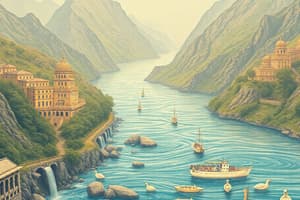Podcast
Questions and Answers
What is considered to be the source stream of the Ganga?
What is considered to be the source stream of the Ganga?
Bhagirathi
At what elevation does the Bhagirathi rise?
At what elevation does the Bhagirathi rise?
3892m
Which is the longest tributary of the Ganga?
Which is the longest tributary of the Ganga?
- Yamuna (correct)
- Sind
- Chambal
- Ken
Which river system is the Ganga a part of?
Which river system is the Ganga a part of?
The Ganga river basin covers about ____ lakh sq.km in India.
The Ganga river basin covers about ____ lakh sq.km in India.
Describe the bifurcation of the Ganga river near Farraka.
Describe the bifurcation of the Ganga river near Farraka.
Match the following rivers with their tributaries.
Match the following rivers with their tributaries.
The Ganga ceases to be known as the Ganga after the confluence at Devprayag.
The Ganga ceases to be known as the Ganga after the confluence at Devprayag.
Name one important town on the banks of the Ganga.
Name one important town on the banks of the Ganga.
Which of the following is not a right bank tributary of the Ganga?
Which of the following is not a right bank tributary of the Ganga?
Where does the Yamuna river originate?
Where does the Yamuna river originate?
What is the approximate total length of the Ganga river?
What is the approximate total length of the Ganga river?
Flashcards are hidden until you start studying
Study Notes
Ganga River System
- The Ganga River, India's national river, flows for approximately 2,525 km from its source to the Bay of Bengal.
- Major confluences include:
- Devprayag: Bhagirathi + Alaknanda
- Rudraprayag: Mandakini + Alaknanda
- Karnaprayag: Pindar + Alaknanda
- Vishnuprayag: Dhauliganga + Alaknanda
- Bhagirathi, rising at Gaumukh (3892m), is considered the river's source stream and joins Alaknanda at Devprayag.
- Yamuna is the longest tributary of the Ganga, originating from Yamunotri Glacier.
- Ganga flows through several Indian states: Uttarakhand (110 km), Uttar Pradesh (1450 km), Bihar (445 km), and West Bengal (520 km).
Delta and Bifurcation
- The Ganga River delta spans about 350 km and discharges into the Bay of Bengal near Sagar Island.
- Near Rajmahal Hills, the river bends southeast and bifurcates at Farraka into:
- Bhagirathi-Hugli (West Bengal)
- Padma-Meghna (Bangladesh)
- After Farraka, it is no longer referred to as the Ganga.
Important Towns Along the Ganga
- Significant towns along the Ganga include Haridwar, Kanpur, Allahabad, Varanasi, Patna, and others.
Alaknanda River
- One of the Ganga's headstreams, Alaknanda rises from the confluence of Satopanth and Bhagirath glaciers.
- It traverses parts of Chamoli, Tehri, and Pauri districts in Uttarakhand.
- The river meets Bhagirathi at Devprayag, after which it is designated as the Ganga.
- Important locations along Alaknanda include the pilgrimage site Badrinath and Tapt Kund hot springs.
Bhagirathi River
- The second headstream of the Ganga, originating at Gaumukh, located at the base of the Chaukhamba peak in Uttarkashi district.
- Major tributaries of Bhagirathi include Bheling, Dhauliganga, and Bishenganga.
Major Tributaries of Ganga
- Right Bank:
- Yamuna, Chambal, Banas, Sind, Betwa, Ken, Son, Damodar
- Left Bank:
- Ramganga, Gomti, Ghaghra, Kali, Gandak, Burhi Gandak, Kosi
Yamuna River System
- The Yamuna originates from Yamunotri Glacier on Banderpoonch peak in the Himalayas.
- Flows through Uttarakhand, Himachal Pradesh, Haryana, enters Delhi, and merges with Ganga near Allahabad (Triveni Sangam).
- Forms the fertile Yamuna-Ganges Doab region in the Indo-Gangetic plains.
- Important cities along its banks include Delhi, Mathura, and Agra.
Major Tributaries of Yamuna
- Key tributaries include:
- Tons, Giri, Hindon, Chambal, Banas, Kali Sindh, Parbati, Sind, Betwa, Ken.
Chambal River
- Known as Charmanwati, the 960 km long Chambal originates from Janapao Hills, Madhya Pradesh.
- Important for hydropower generation through dams like Gandhi Sagar, Jawahar Sagar, and others.
Studying That Suits You
Use AI to generate personalized quizzes and flashcards to suit your learning preferences.




